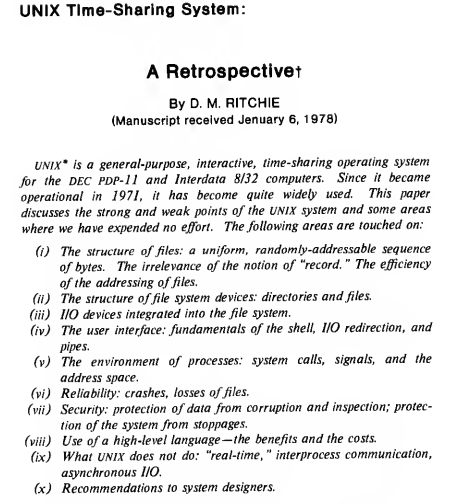I don’t think I’ve posted about this before, it’s 24 short pages looking back at Unix from a 1978 perspective. I think I turned it up because I was interested - am still interested - in the history of which CPU architectures, first ran some version of Unix, and when.
UNIX* is a general-purpose, interactive time-sharing operating system primarily for the DEC PDP-11 series of computers, and recently for the Interdata 8/32. Since its development in 1971, it has become quite widely used, although publicity efforts on its behalf have been minimal, and the license under which it is made available outside the Bell System explicitly excludes maintenance. Currently, there are more than 300 Bell System installations, and an even larger number in universities, secondary schools, and commercial and government institutions. It is useful on a rather broad range of configurations, ranging from a large PDP-11/70 supporting 48 users to a single-user LSI-11 system.
UNIX* is a general-purpose, interactive, time-sharing operating system
for the DEC PDP-11 and Interdata 8/32 computers. Since it became
operational in 1971, it has become quite widely used. This paper
discusses the strong and weak points of the UNIX system and some areas
where we have expended no effort. The following areas are touched on:
- (i) The structure of files: a uniform, randomly-addressable sequence of bytes. The irrelevance of the notion of "record. " The efficiency of the addressing of files.
- (ii) The structure of file system devices: directories and files.
- (iii) I/O devices integrated into the file system.
- (iv) The user interface: fundamentals of the shell, I/O redirection, and pipes.
- (v) The environment of processes: system calls, signals, and the address space.
- (vi) Reliability: crashes, losses of files.
- (vii) Security: protection of data from corruption and inspection; protection of the system from stoppages,
- (viii) Use of a high-level language— the benefits and the costs.
- (ix) What UNIX does not do: "real-time, " interprocess communication, asynchronous I/O.
- (x) Recommendations to system designers.
